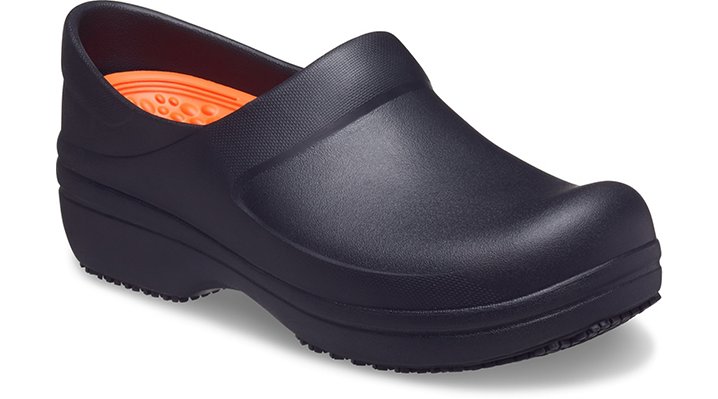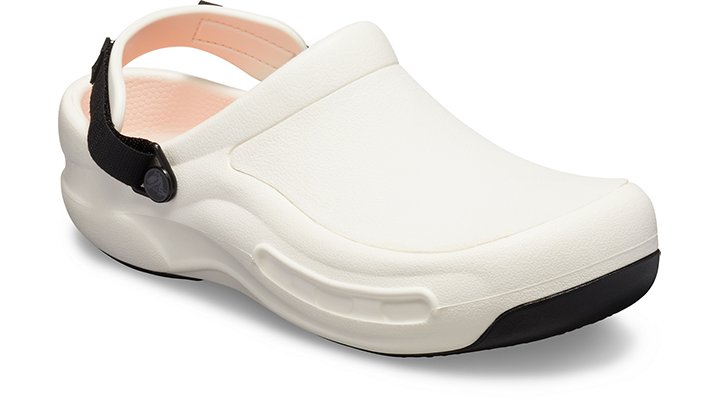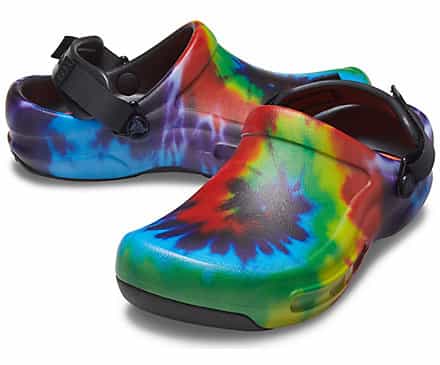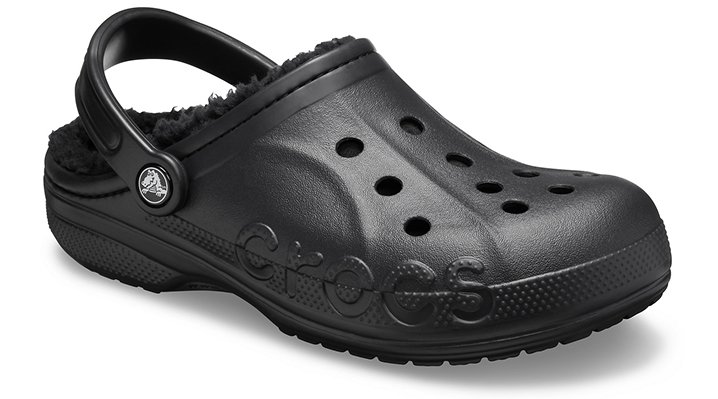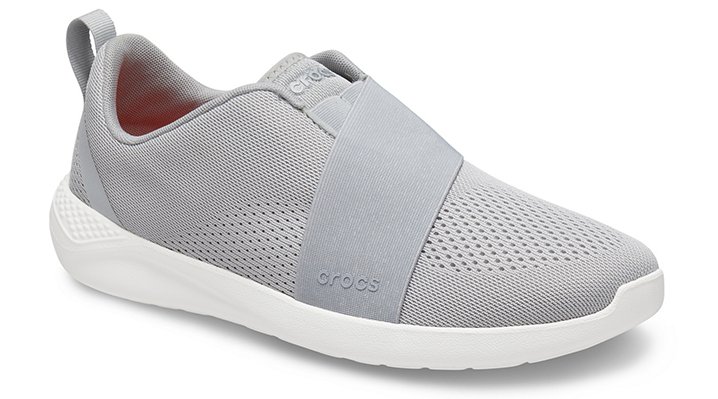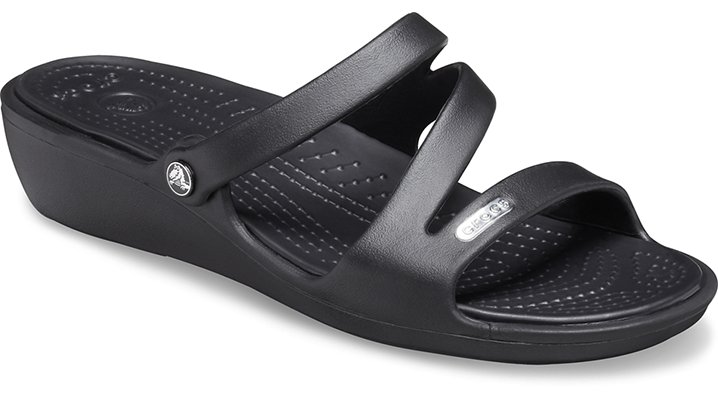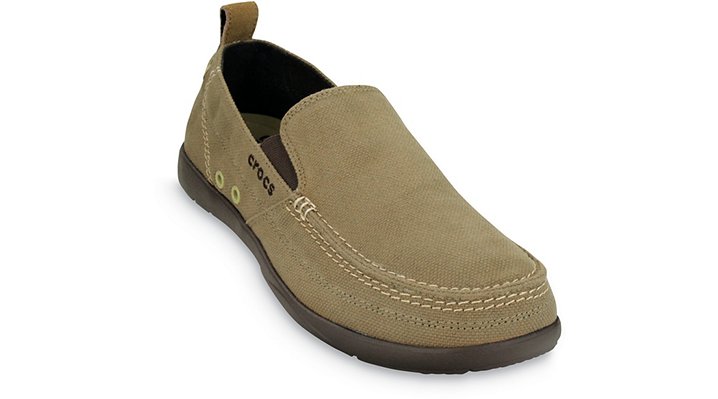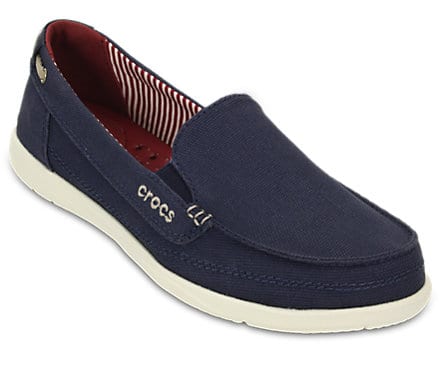Crocs for Diabetics: Pros, Cons and Best Products

Are Crocs suitable for people with diabetes? Crocs’ famous foam clogs are designed to add comfort and stability to the foot and reduce muscle fatigue by 60 percent. They even received the official seal of approval from both the APMA and the U.S. Ergonomic Council.
Does it mean that Crocs are suitable for all people with diabetes? If you live with either type 1 or type 2 diabetes, and even more if you have peripheral neuropathy, you must choose your footwear carefully. Crocs can be an excellent choice for some of us, but not necessarily for everyone.
This article balances the pros and cons of wearing Crocs if you have diabetes and diabetes-related foot problems. You’ll find a selection of the best and most protective Crocs models for diabetic and neuropathic feet.
Table of Contents
Crocs Benefits for People with Diabetes and Fragile Feet
People with diabetes are more prone to develop serious foot problems than the general population. Wearing diabetes-friendly shoes, socks, and insoles is essential to alleviate and prevent foot pain.
It did surprise me when I first read that Crocs were diabetes-friendly shoes. I started writing articles about diabetic footwear and came across many podiatrists and foot professionals recommending the famous clogs for their patients with diabetes and neuropathy. After investigating the topic, I understand better why Crocs can benefit people with diabetes.
Crocs are certified by the U.S Ergonomic Council & the APMA
If today Crocs are famous in fashion, they were first created as ergonomic and therapeutic shoes to alleviate plantar pain and achy feet. The U.S Ergonomic Council and the American Podiatric Medical Association have officially approved Crocs’ design, acknowledging the health benefits for people with various foot problems, including diabetes and neuropathy.
Wide toe box and no pressure points
Crocs’ clogs have extra room in the toe area. It’s great for sensitive skin people who need to avoid friction or squeezing points.
Plus, people with diabetes and neuropathy often suffer from insufficient blood circulation. Extra toe room keeps the toes constantly moving and promotes blood flow.
Ultimately, it helps prevent further foot problems. Crocs clogs are non-binding shoes. They won’t constrict your legs, and they won’t cause pressure points.
Enhanced arch support
Crocs are known for the solid arch support they provide. Arch support is essential, especially if you suffer from plantar fasciitis foot pain. It distributes the pressure on your foot and helps eliminate pressure points. Your plantar fascia ligament may get torn and damaged without proper arch support.
Ultimately, arch support considerably reduces foot pain.
Crocs Croslite material is anti-bacterial
Crocs are made from Croslite, a closed-cell resin that’s trademarked by the company and manufactured by itself. They’re made neither from plastic nor rubber. Croslite is very lightweight. It’s soft. It’s odor resistant.
And most importantly, for diabetics, it’s naturally anti-microbial and prevents fungal and bacterial growth.
Foam clogs are lightweight shoes
Diabetic footwear is recommended to be as lightweight as possible. It should let your feet move and breathe and facilitate motion.
Croslite resin is exceptionally lightweight yet durable.
Crocs are easy to clean, so your feet stay healthy
Croslite is easy to clean. Use regular soap and water. The shoes won’t absorb the water and dry instantaneously.
Keeping your feet in a clean and healthy shoe environment is essential when living with diabetes. It helps prevent infections that could lead to severe complications such as foot ulcers.
Are Crocs Good for Everyone with Diabetes?
Crocs clogs have numerous health benefits for achy feet, but it does not mean they’re suitable for everyone.
Crocs are not authentic orthopedic shoes.
They’re mass-produced and made to fit “most feet.” Clogs won’t be appropriate if you have severe foot conditions due to diabetes, neuropathy, or others.
Some cases require custom-made orthopedic footwear or professionally designed shoes for diabetes. In any case, you should seek your doctor’s and podiatrist’s advice.
Crocs are not suitable for serious foot complications
Peripheral neuropathy is a common diabetes complication affecting the nerves of your body extremities. When the nerves of your feet are damaged, you can suffer from foot pain, tingling, burning sensation, and loss of sensitivity. Often associated with poor blood circulation, neuropathy considerably reduces the healing process. It increases the risks of infections leading to foot ulcers and lower-limb amputations in the worst cases.
Peripheral neuropathy is severe, and your feet must be fully protected. Crocs shoes are not designed to address such advanced foot problems. You should be wearing orthopedic footwear.
Podiatrists don't recommend wearing Crocs all day long
Many podiatrists recognize the benefits of Crocs for people with achy feet. However, I haven’t heard of any foot professional who recommends diabetic patients to wear their Crocs all day long and Crocs only.
Crocs are very comfortable, have a wide toe box, and provide good arch support. But they don’t secure the heel as much as needed. When the back of your foot is not supported enough, you tend to grip the shoe with your toes to prevent it from slipping off. It can cause tendinitis, bunions, hammertoes, or nail problems.
Crocs are good shoes for people with diabetes to wear daily. Go to the shop, wander around the garden, be at home, or have short walks. But you should not be wearing them if you’re walking long distances.
Seek a Podiatrist's advice
Foot care is an essential part of diabetes management. You should wear appropriate diabetic shoes, socks, and insoles to avoid complications.
People with diabetes should have a diabetic foot exam at least once a year to diagnose potential problems before they get too serious. Do talk with your doctor about your exam schedule.
As someone with diabetes, one should carefully choose their shoes, even more so if affected by peripheral neuropathy.
How to Choose your Crocs if you Have Diabetes?
If you have diabetes and want to wear Crocs, let’s choose the ones that best suit your feet and address your foot problems. There’s much more than the Classic Crocs, and some models are more protective and supportive than others. Here’s a list of optional Crocs features you should be looking for to benefit optimum comfort and protection:
Prefer enclosed toes Crocs
For enhanced breathability, Classic Crocs clogs come with 13 holes in them. While these holes thoughtfully promote airflow so our feet can breathe, they also let foreign objects enter the shoe. Grains of sand or pebbles in your shoes cause wounds.
People with diabetes have a slow healing process. Injuries often lead to infections. Infections can lead to foot ulcers. A foot ulcer is the first cause of lower-limb amputations. I prefer enclosed-toe Crocs to avoid this series of problems!
Clogs with heel straps secure your steps
Most Crocs models today have heel straps at the back. This allows maintaining your feet adequately placed and securing your steps.
Choose Crocs with LiteRide removable insoles
The clog’s company has recently launched new models with removable LiteRide insoles. These next-generation foam insoles are very soft and provide remarkable cushioning. They’re removable and washable.
Crocs LiteRide comes at a slightly higher price than regular Crocs, but it’s an investment you won’t regret. Insoles are probably the most crucial part of your shoes, and as a person with diabetes, you should not compromise on them.
Roomy Crocs for wide or swollen feet
Different Crocs models have different fits. On Crocs.com, you can choose filters on the left side. A “fit” filter lets you choose clogs according to their fit: standard, relaxed or roomy. Remember that diabetic footwear has to be non-binding and roomy. The purpose is to avoid any pressure points and promote blood flow. I prefer Crocs that have a relaxed or roomy fit.
Outsole with anti-slip threads is bonus
The Croslite foam outsoles are slip-resistant, and some Crocs models even have additional anti-slip threads. It’s not a diabetes essential per se, but it’s a welcome addition to secure your steps. These will prevent you from falling on slippery floors.
Best Crocs For Diabetics: Clogs Style!
Now that you know everything about Crocs shoes and diabetes, I’ve selected the three best clog models for people with diabetes. The following are Crocs designed to offer the most comfort, protection, and foot support. They would be the most suitable ones for people with diabetes to wear safely.
1. Neria Pro II LiteRide: Most Protective Crocs for Women with Diabetes
The Neria Pro II LiteRide for women is the most diabetes-friendly Crocs you can wear. This new model was recently launched.
They come with removable LiteRide™ foam insoles known to be exceptionally soft and to deliver superior support and cushion. The arch support is good, and the footbeds have a bottomless cup.
Even though these insoles are pretty good, if you need extra support or different features, you can substitute them with insoles specially designed for diabetes or neuropathy. Inserting top-quality insoles is quite valuable for us living with diabetes. Not every Crocs have removable insoles.
Neria Pro II LiteRide’s toes and heels are enclosed for more excellent feet protection. Enclosed Crocs are especially suited for neuropathy, sensitive, blistering, slow-healing skin. It prevents foreign objects from entering your shoes and hurting you.
The Croslite™ foam outsoles are slip-resistant, lightweight, supportive, and long-lasting.
The Neria Crocs have a relaxed fit that doesn’t constrict your feet. They are wide at the back, so they’re easy to put on and off, and they have extra room for the toes, so you avoid friction.
- Get Neria Pro II LiteRide Crocs if:
- Your looking for women's clogs with extra comfort and feet support
- You want to insert your own diabetic insoles into your Crocs
- You need roomy shoes because you have swollen or wider feet
- You prefer Crocs with enclosed toes and heels for greater protection
- Don't get Neria Pro II LiteRide Crocs if:
- You care about style. This new model is only available in black
- You're on a budget. Neria Pro LiteRide are the most expensive of all Crocs clogs
2. Bistro Pro LiteRide: Most Supportive Crocs for Men with Diabetes

We can only regret there is no equivalent to Neria Pro II LiteRide Crocs for Men. The most similar men’s product is the Bistro Pro LiteRide. Part of the “Crocs at work” line, it’s specially made for people working long shifts standing up.
The enclosed toe design with a thicker metatarsal upper provides enhanced protection compared to classic clogs. The next-generation LiteRide™ thick-foam insoles are removable. This is an excellent feature because even if Crocs’ LiteRide insoles are comfortable, lightweight, and supportive, you might prefer wearing your Crocs with insoles specially designed for diabetes or neuropathy.
The outsole comes with Crocs Lock slip-resistant threads and considerably reduces the risks of falling on slippery floors.
Bistro Pro LiteRide Crocs are extra roomy. They perfectly fit wider or swollen feet and sensitive neuropathic ones. Overall, these are the best Men’s Crocs for diabetes and neuropathy. They’re available in Black, White, and Graphic design for the most stylish ones of us!
- Get Crocs Bistro Pro LiteRide if:
- Your looking for men's clogs with extra comfort and feet support
- You want to costumize your Crocs and insert your own orthotics or insoles into your Crocs
- You have wider or swollen feet and need extra roomy Crocs
- You prefer enclosed toes and heels for more protection
- Don't get Crocs Bistro Pro LiteRide if:
- You're on a budget. Bistro Pro LiteRide are the most expensive Crocs' clogs for men
3. Baya Lined All Seasons Crocs: Best for Diabetics' Sensitive Feet
Crocs’ Baya Lined all seasons clogs are available for both men and women. The interior is fully lined with highly soft fluffy plush that keeps your feet in cocoon-like heaven!
They’re ideal for people with diabetes with neuropathy, sensitive feet, blistering skins, or slow-healing problems. The shoe lining is very gentle on your feet and protects your skin against rubbing, friction, and blisters.
Baya Lined Crocs have enhanced arch support, and the footbeds are deeply cushioned. The durable Croslite™ foam outsoles are supportive and have good shock absorption capacity.
The heel straps at the back pivot, so you can put them on or off. When on, they help improve motion and secure your steps—an excellent choice for Crocs lovers living with diabetes who need comfortable fit shoes.
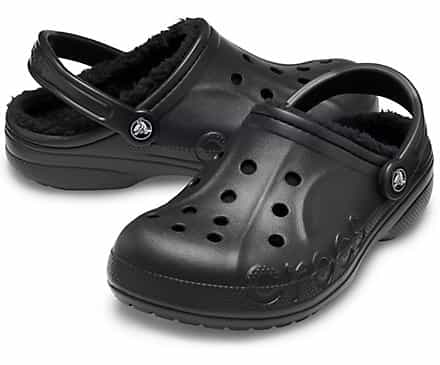
- Get Baya Lined or Classic Lined Crocs if:
- You have neuropathy, sensitive or slow-healing skin
- You want to wear your clogs all seasons
- You prioritise motion and secure step
- You need non-binding shoes with extra room
- Don't get Baya Lined or Classic Lined if:
- You want to wear your Crocs with customizable diabetic insoles
- You're on a budget. They're the most expensive Crocs' clogs for men
4. Crocs RX Silver Relief and Silver Cloud - Discontinued
Crocs RX Silver and Cloud Relief were the most recommended Crocs for people with diabetes. Unfortunately, the company has discontinued these models. The closest Crocs you can find for diabetes and neuropathy patients to wear safely are the ones presented above. I will update this article when the company re-launch these products.
Best Crocs For Diabetics: Sneakers, Sandals, and Loafers
The Colorado company has built its fame with foam clog-style shoes. Today its catalog offers more than 120 models of comfort shoes for men, women, and kids, including sneakers, sandals, loafers, boots, etc. Here are a few of the most recommended ones for people with diabetes.
1. LiteRide™ Modform Slip-On: Best Crocs' Sneakers for Diabetics (Men)
The first thing to look for when buying diabetic footwear is non-binding. People with diabetes and neuropathy tend to have poorer blood flow in the lower limbs. Your shoes mustn’t constrict your ankles and feet and promote circulation.
Crocs LiteRide Modform slip-ones are great for that purpose. The engineered knit uppers are soft and flexible with perforations. They adjust to your feet without squeezing them. The fit is relatively relaxed and leaves enough room for your feet.
Thanks to a pull tab at the back, they’re easy to put on and off. They give your feet a slipper-like feel. Extremely comfortable, these sneakers feature great insoles and outsoles. The LiteRide foam insoles are lightweight and well-cushioned. Removable, you can wash them or substitute them with more diabetic-friendly orthotics. The Croslite outsoles provide excellent foot support and shock absorption for all-day comfort.
The interior is soft and non-irritative, which is excellent for sensitive skin.
It’s an excellent choice for people with diabetes who are looking for a bit of extra comfort. However, I recommend looking for authentic orthopedic shoes if you have severe foot problems or neuropathy complications. Crocs are good at what they’re made for, but they’re as protective as shoes professionally designed for diabetes and neuropathy.
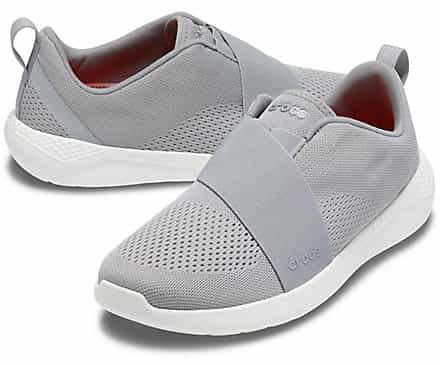
- Get Crocs Modform Slip-on Sneakers if:
- You're looking for comfortable non-binding sneakers
- You want to wear your Crocs' sneakers with your diabetic insoles
- You like lightweight and relaxed-fit shoes
- Don't get Crocs Modform Slip-on Sneakers if:
- You need enhanced arch support
- You have serious foot problems or neuropathy complications. In that case, you should look at real orthopedic shoes.
2. Patrica Wedges: Best Crocs' Sandals with Arch Support for Women with Diabetes
Because of their open design, sandals are not the most recommended footwear for people with diabetes and neuropathy. I’ve written a complete buyer’s guide to choosing sandals for people with diabetes.
The Patricia Wedges Crocs are pretty good! Customers’ reviews mention unsurpassed comfort. The straps are soft and flexible, so they’re blister-proof and don’t irritate your skin.
These sandals come with enhanced arch support that would fit even high arches. The footbeds are deeply cushioned, super squishy, and have dozens of massage pods!
They feature Crocs’ CrosLite ergonomic outsoles, remarkable for their high impact absorbing and cushioning properties. The resin material is anti-bacterial. It limits fungal and odor-causing bacteria growth, which is immensely valuable for summer shoes.
To conclude: Patricia’s sandals are supportive, comfortable, non-irritative, well-cushioned, and massaging. A great summer choice for diabetic women who want to take good care of their feet! They’re available in Black, Oyster, and Navy.
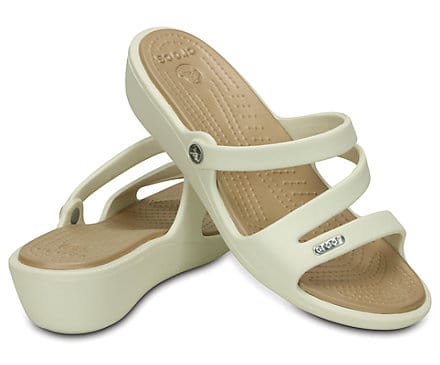
- Get Crocs Patricia Wedges for women if:
- You're looking for the most comfortable sandals for the summer
- You need enhanced arch support
- You tend to have fungus and bacterial infections or smelly feet
- You'll enjoy the massage-pod footbeds!
- Don't get Crocs Patricia Wedges for women if:
- I sincerely don't know why would would not get them!
3. Walu Slip-on: Best Crocs' Loafers for Diabetics
Crocs’ Walu slip-ones are a great choice if you’re looking for diabetes-friendly loafers. This is a new model that is very cozy and relaxed.
These loafers come with removable microfiber shoe inserts with excellent cushioning and ventilation. Extra breathable thanks to added side ports and arch ventilation mesh, your feet will benefit from excellent airflow in an overall healthy environment.
They have a deep heel cup that enhances foot stability and support. The interior lining is soft and non-irritative.
Crocs Walu slip-one features the CrosLite outsoles with improved shock absorption capacity to protect your feet and soothe every step. They’re very lightweight and casual. Great for walking short to medium distances. Available in many different colors.
- Get Crocs Walu Loafers if:
- You're looking for comfortable diabetes-friendly loafers
- You need extra-breathable shoes
- You want to wear your Crocs with your own diabetic insoles
- Don't get Crocs Walu Loafers if:
- You need wider shoes with extra room. These are regular fit and might constrict your feet if you tend to swell.
- You need enhanced arch support
Crocs and Diabetes: Frequently Asked Questions
Before rushing to buy your new Crocs, a few questions have already been answered about Crocs for diabetes. It might help you make an intelligent purchase decision.
Can you put insoles in Crocs?
You can put insoles in Crocs if it leaves enough room for your feet. The new generation LiteRide Crocs have removable inserts that you can easily substitute with your custom-made or favorite orthotics. If you purchase Crocs models with non-removable insoles and want to put your shoe inserts inside, you should buy one size up, so there’s enough room.
Are Crocs good for Plantar Fasciitis?
Plantar Fasciitis is an inflammation of the plantar fascia ligament, which connects the heel to the forefoot. The plantar fascia supports your arch and helps absorb shocks when walking. When the ligament is damaged or torn by too much pressure, it can cause torturous pain at the bottom of the foot. This is Plantar Fasciitis, and it’s a widespread orthopedic problem. The most efficient treatment for plantar fasciitis is wearing shoes with good arch support.
Crocs’ Specialist line of clogs, called “Crocs at work,” is designed for professionals who spend hours on their feet and suffer from plantar fasciitis pain. They considerably alleviate plantar fasciitis discomfort by featuring contoured footbeds and good arch support.
Do Crocs have arch support?
Crocs shoes are known to have excellent arch support. At the origins, the clog type of shoes was made for farmers who spent hours doing hard labor on their feet and suffered plantar foot pain. Crocs have designed a line of clogs for working professionals that provide good orthopedic arch support. They’re ideal for people with Plantar Fasciitis foot pain who need arch support. You can also insert your orthotics in your Crocs. Some insoles do provide enhanced extra arch support for high arch foot types.
Are Crocs good for swollen feet?
Crocs are a great footwear choice for people with swollen feet. Whether you have edema, swollen feet during surgery recovery, or broader feet, Crocs’ design is wide enough so it doesn’t squeeze your feet. They’re easy to put on and off. They’re flexible and very comfortable. Foam clogs are often medically recommended for people suffering from swollen feet after surgery. You might also want to consider wearing non-binding socks if you have swollen feet.
Are Crocs good for flat feet?
Flat feet need good support, reinforced heel, and flexible material. Crocs clogs provide all of that and are good shoes for people with flat feet.
Can Crocs damage your feet?
Crocs won’t damage your feet if worn reasonably. Clogs are not made to be worn all day long, nor are they running shoes or hiking shoes. If Crocs clogs provide significant health benefits for people with foot problems, including diabetes and neuropathy, you shouldn’t wear them more than a few hours a day. They’re ideal for walking around the house, gardening, going to the shop, walking short distances, etc. But Classic Crocs’ design does not secure the heel enough, making us grab the shoe with our toes. It’s no problem if it’s not all day long, but walking long distances with clogs can ultimately cause tendinitis, deformities, or nail problems.
Can you eat your Crocs shoes?
What? Yes, that’s a question that’s often asked! It comes from the fact that Crocs are made from Croslite closed-cell resin, a non-toxic material. Technically, you could eat your Crocs. I don’t recommend it, though…
I hope this article has been helpful to you. Do not hesitate to share and comment!
